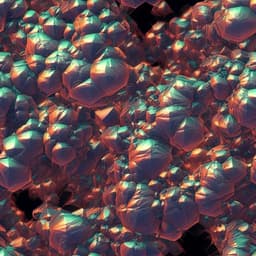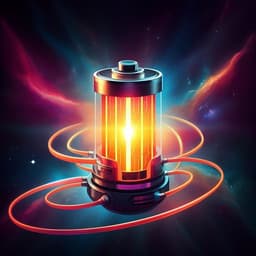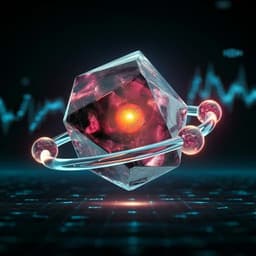
Engineering and Technology
Molecular anchoring of free solvents for high-voltage and high-safety lithium metal batteries
Z. Cui, Z. Jia, et al.
Discover a groundbreaking molecular anchoring approach aimed at enhancing the stability of high-voltage lithium metal batteries. This innovative research, conducted by Zhuangzhuang Cui, Zhuangzhuang Jia, Digen Ruan, Qingshun Nian, Jiajia Fan, Shunqiang Chen, Zixu He, Dazhuang Wang, Jinyu Jiang, Jun Ma, Xing Ou, Shuhong Jiao, Qingsong Wang, and Xiaodi Ren, suppresses ether side reactions and mitigates thermal runaway risks, paving the way for safer battery technologies.
~3 min • Beginner • English
Introduction
The study addresses a central challenge in lithium metal batteries (LMBs): enabling high-voltage operation with ether-based electrolytes that are reduction-stable at the Li metal anode but suffer from poor anodic (oxidation) stability (<4.0 V vs Li+/Li). Conventional carbonate electrolytes react strongly with Li metal, yielding porous, unstable SEI and promoting dendrite growth, whereas ethers support better Li metal compatibility but degrade at high cathode potentials—particularly on Ni-rich cathodes (e.g., NMC811) with reactive surface sites. Prior strategies, notably high-concentration and localized high-concentration electrolytes (HCE/LHCE), reduce free ether molecules through strong Li+-solvent coordination and form inorganic-rich interphases via anion involvement; however, they still face limited anodic stability (<4.5 V), sluggish ion transport, high salt cost, poor low-temperature performance, and potential safety risks due to reactive anions. The paper proposes a hypothesis that non-conventional hydrogen-bonding between ether solvents (e.g., DME) and hydrofluoroether anchoring agents (e.g., TTE) can thermodynamically elevate ether oxidation stability and suppress interfacial reactivity without relying on anion-derived passivation, thereby enabling high-voltage cycling and improved safety in dilute electrolytes.
Literature Review
- HCE/LHCE strategies limit free ethers via Li+ coordination, enrich anions in the inner solvation sheath, and promote inorganic-rich CEI/SEI (e.g., LiF) to kinetically suppress side reactions but still struggle above ~4.5 V and impose transport and cost penalties.
- Artificial CEIs and desolvating interphases can physically isolate electrolytes from high-voltage cathodes but do not address the intrinsic reactivity of free solvents.
- Safety literature emphasizes that nonflammability alone does not ensure battery safety; exothermic reactions between electrolyte and electrodes (graphite, delithiated cathodes, and Li metal) can trigger thermal runaway, with heat release often increasing with salt concentration.
- Reported observations show concentrated electrolytes with reactive anions can exacerbate heat generation and thermal runaway, even when flame-retardant solvents are used.
- The role of LiF-rich interphases is recognized for electronic insulation and stability, yet excessive anion participation at high voltages leads to thick CEI growth and performance decay.
Methodology
Electrolyte design: Molecular anchoring diluent electrolytes (MADE) were formulated with low salt content and high diluent ratio using LiFSI:DME:TTE molar ratios of 1:9:27 (~0.19 M, MADE-1), 2:9:27 (~0.38 M, MADE-2), and 3:9:27 (~0.56 M, MADE-3). A reference LHCE (LiFSI·1.2DME·3TTE) and a dilute electrolyte (DE, LiFSI·9DME) were also used.
Molecular interactions and solvation analysis:
- Isothermal titration calorimetry (ITC) quantified DME–TTE interaction heats versus HCE added into TTE.
- 2D 1H–19F HOESY NMR, 1H and 17O NMR characterized non-conventional H-bonding (CF2H of TTE as donor to O of DME), supported by FT-IR blue shifts of CF2–H with deuterated ethers (THF-d8) and DMSO-d6.
- DFT geometry optimizations, deformation charge density, and electrostatic potential (ESP) maps analyzed preferred complexes (DME–TTE vs TTE–TTE vs DME–DME) and changes around O(DME).
- Raman and IR spectroscopy probed Li+ coordination evolution (free FSI, CIP, AGG; Li+-coordinated DME bands) across MADEs to LHCE.
- Classical MD simulations (COMPASS II, Materials Studio) provided solvation structures, radial distribution functions (RDFs), and coordination numbers for Li+ with O(DME), O(FSI), and TTE.
Electrochemical testing:
- LSV, CV, and chronoamperometry/leakage current on Li||PVDF+SP/Al and Li||NMC811 coin cells (2.8–4.7 V windows) assessed oxidation onset and stability; rate and cycling at C/3 (after two formation cycles at C/10) to 4.7 V.
- Generality checks with other solvents/diluents (G2, HFE, DMC) and salts (LiPF6, LiTFSI) and varying anchor concentrations.
- Li||Cu Coulombic efficiency (0.5 mA cm−2, 1 mAh cm−2) and Li morphology; Li symmetric cell overpotential/lifespan.
Interface characterization:
- SEM and HR-TEM measured CEI morphology and thickness on NMC811 after 50 cycles.
- XPS with Ar+ depth profiling quantified CEI/SEI compositions (F 1s, O 1s, N 1s, S 2p, Ni 2p) and F/S ratios.
- Soft XAS (O K-edge, S L-edge, TEY) probed near-surface chemistry; ex-situ 19F NMR tracked anion decomposition.
- In situ XRD studied H1→H2→H3 phase transitions vs electrolyte-derived CEI effects.
- AFM modulus mapping assessed SEI mechanical properties.
Thermal safety evaluations:
- DSC of electrolytes with Li metal or charged NMC811 (4.6 V) using sealed gold-plated stainless-steel crucibles.
- ARC tests on 2 Ah Li||NMC811 pouch cells (N/P 2.1; 3 g Ah−1 electrolyte) precharged to 4.6 V; recorded dT/dt vs T to identify thermal runaway thresholds.
Computation of oxidation potentials:
- DFT (Gaussian16, B3LYP/6-311++G(d,p), implicit solvent ε=7.3) on MD-derived complexes to calculate Eox vs Li/Li+ for DME–FSI (two configurations) and DME–TTE using free energy differences.
Key Findings
- Molecular anchoring via H-bonding: Strong exothermic mixing (ITC ~706.1 cal mol−1 per drop for DME→TTE) evidences DME–TTE interaction; diminished when DME is Li+-coordinated (HCE ~185.9 cal mol−1). Spectroscopy and DFT identify CF2H(TTE)→O(DME) H-bonds as dominant, increasing ESP minima around O(DME) (from −42.75 to −17.22 kcal mol−1), indicative of enhanced oxidative stability.
- Solvation structure: In MADE-1, Li+ primary shell dominated by O(DME) with minimal TTE coordination; O(DME):O(FSI) coordination number ratio ~3.7 (decreasing to 1.31 in MADE-3 and 0.42 in LHCE), showing shift from solvent-dominated to anion-aggregated structures with increasing salt.
- Oxidation stability: Onset potentials increase as salt content decreases; MADE-1 to MADE-3 stable beyond 4.7 V (MADE-1 highest ~4.77 V) vs LHCE ~4.60 V. Leakage currents at 4.6–4.7 V are lower in MADEs than LHCE. Generality: similar improvements observed with other solvents/diluents (G2, HFE, DMC) and salts (LiPF6, LiTFSI); higher anchor concentration further boosts stability.
- Full-cell performance (Li||NMC811, 2.8–4.7 V): MADEs enable reversible cycling; LHCE and higher-salt electrolytes show early overcharge and polarization growth. At C/3, capacity retention over 100 cycles: MADE-2 95.0%, MADE-1 88.5%, MADE-3 86.2%; LHCE exhibits fast decay and voltage polarization. MADEs show lower viscosity and higher ionic conductivity, improving 2C/4C rate capacities (MADE-1 lowest capacity among MADEs due to extreme dilution).
- Cathode–electrolyte interphase: SEM/HR-TEM reveal thin, uniform CEIs in MADE-1 (~1 nm) and MADE-3 (~3.2 nm) vs thick in LHCE (~20.1 nm). Raman mapping shows stronger NMC811 signals (385–700 cm−1) for MADE-1, consistent with thinner CEI.
- CEI chemistry: XPS and XAS indicate decreased anion-derived decomposition (lower N-Ox/S-Ox accumulation) and higher F from TTE in MADEs (higher F/S ratios), while LHCE shows significant FSI oxidation signatures (O K-edge peaks near Li2SO4; S L-edge) and thicker CEI. Ex-situ 19F NMR shows growing anion-decomposition signal in LHCE over cycles.
- Mechanism of anodic stability: DFT oxidation potentials: DME–FSI ~5.002–5.070 V with spontaneous H transfer (most susceptible), DME–TTE ~5.739 V. MADE shifts dominant species from DME–FSI to H-bonded DME–TTE, elevating oxidation threshold and suppressing side reactions without relying on CEI protection (confirmed by swapping CEI-coated cathode into LHCE which reintroduces anodic currents >4.6 V).
- Cathode structural reversibility: In situ XRD shows MADE-1 enables larger H1→H2 layer-spacing change (0.34°) vs LHCE (0.24°), consistent with fewer trapped Ni2+ and lower impedance; LHCE exhibits thicker CEI, higher polarization, and propensity for irreversible transformations.
- Li metal compatibility: Li||Cu average CEs: DE 87.8% (unstable), MADE-1 >99.00%, MADE-2 99.12%, MADE-3 99.30%, LHCE 99.24% (but higher overpotentials). MADEs produce compact Li deposits; SEI in MADE-1 is thinner with higher organic C (C–C/C–H 284.8 eV; C–F 290.2 eV) and higher F/S (more TTE participation), yielding a more flexible SEI (AFM lower modulus vs LHCE). LHCE’s anion-rich SEI is thicker, more rigid, and associated with higher Ni 2p (crosstalk/cathode corrosion).
- Thermal reactivity and safety: DSC with Li shows LHCE releases heat above ~50 °C; MADE exotherms shift to higher T, with MADE-1 showing no apparent heat release before Li melting (~180 °C). DSC with charged NMC811 also shows suppressed exotherms as salt ratio decreases. Despite DE being flammable (SET 81 s g−1), MADEs and LHCE are hard to ignite due to fluoroether content. ARC on 2 Ah pouch cells: thermal runaway threshold (dT/dt > 1 °C min−1) increases from 141 °C (LHCE) to 209 °C (MADE-1).
- Overall: MADE delivers a wide electrochemical stability window (>4.7 V on NMC811), improved cycling/rate performance, high Li metal CE with flexible SEI, and markedly improved safety (postponed thermal runaway).
Discussion
The work demonstrates that molecular anchoring through non-conventional H-bonding between hydrofluoroethers (e.g., TTE, CF2H donor) and ether solvents (DME) elevates the ether’s oxidation potential and reduces interfacial reactivity at high-voltage cathodes. By shifting the dominant interfacial species from DME–FSI (anion-involved, lower Eox) to H-bonded DME–TTE (higher Eox), MADE suppresses solvent oxidation without requiring anion-driven CEI formation. Consequently, thin, uniform CEIs form on NMC811, minimizing impedance and preserving structural transitions, enabling stable cycling to 4.7 V with reduced polarization growth. On the anode, reduced anion participation and TTE involvement in SEI construction yield thinner, more organic/fluorinated and mechanically flexible SEIs that accommodate volume change and support high Li CE with lower overpotentials. The decreased reactivity of anions also mitigates exothermic reactions with Li metal and charged cathodes, substantially delaying thermal runaway in pouch cells. Compared to LHCE, MADE decouples anodic stability from high anion content, avoids the transport penalties of high salt, and enhances safety, thereby addressing the initial research question of achieving high-voltage, high-safety operation in ether-based LMBs through thermodynamic stabilization of solvents at the interface.
Conclusion
This study introduces molecular anchoring diluent electrolytes (MADE) that leverage CF2H→O hydrogen bonding between hydrofluoroether anchors (e.g., TTE) and ether solvents (DME) to thermodynamically elevate solvent oxidation stability. The approach enables dilute electrolytes (~0.19–0.56 M) with a wide anodic window (>4.7 V on NMC811), improved cycling and rate performance, high Li metal Coulombic efficiency (>99%), thin/flexible interphases, and enhanced safety, including a significant increase of thermal runaway temperature from 141 °C (LHCE) to 209 °C (MADE-1). DFT shows DME–TTE complexes possess much higher oxidation potentials than DME–FSI, explaining the suppressed side reactions without relying on thick, anion-derived CEIs. The MADE concept generalizes across salts and co-solvents/diluents. Future work should optimize salt chemistry/reactivity and anchor concentrations to balance SEI formation, ionic conductivity, and long-term symmetric-cell lifespan, and to extend MADE to other high-voltage cathodes and practical conditions.
Limitations
- Extreme dilution (e.g., MADE-1, ~0.19 M) reduces ion concentration, contributing to relatively lower capacities at high rates and shorter symmetric-cell lifespans compared with higher-salt systems (trend LHCE > MADE-3 > MADE-1).
- Optimal performance requires balancing anchor and salt contents; insufficient anion participation may limit SEI ionic conductivity, whereas excessive anion involvement (LHCE) leads to thick, rigid interphases.
- While generality is demonstrated with select salts and solvents, the study focuses primarily on LiFSI/DME/TTE; broader validation across more chemistries and long-term/practical cycling conditions remains for future work.
Related Publications
Explore these studies to deepen your understanding of the subject.







